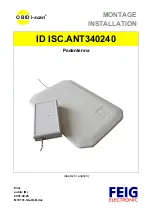
4
Type of installation
Parts you must supply
Tools you must supply
ALL INSTALLATIONS
• Coaxial cable (see “Cable specifications” on
page 9)
• Weatherproof 360° cable connectors
• Cable ties
• Insulated U-shaped tacks
• F-type ground block and screws
• 1/4-inch washer (for grounding if not using RG-6
quad shielded cable)
• #6 washer (to help with drilling)
• Silicone sealant
• 8AWG aluminum and/or 14AWG copper ground
wire, as required for installation or grounding
scheme
• If not using RG-6 quad shield coaxial cable, one
split bolt with nut for connections at the ground
block
• Compass
• Angle finder or protractor
• Carpenter’s level
• Pencil or chalk
• Ladder or stepladder
• Electric drill
• Ruler and tape measure
• Adjustable wrench (socket preferred)
• Torque wrench (up to 18 ft.-lbs.)
• Open-end or socket wrenches: 3/16, 1/2, 5/16,
7/16, 9/16-inch
• Needle-nose pliers
• Lineman pliers
• String
• #2 Phillips or similar screwdriver
• Flat-blade screwdriver
• Hammer
• Permanent marker
Wood post
All parts supplied
• Drill bits: 3/8, 1/4, and 1/8-inch
Wood frame roof
• If you decide to use 5/16-inch x 4-inch lag screws
for this installation, you must provide them and the
5/16-inch galvanized washers
• Drill bits: 3/8, 1/4, 1/8, and 5/32-inch
Concrete masonry or
concrete wall
• 3/8-inch x 3-inch Hilti sleeve anchor, Qty: 6
• If also installing optional brace kit, 1/4-inch x 2-1/4-
inch Hilti sleeve anchor, Qty: 4
• Hammer drill
• Masonry drill bits: 3/8-inch
Metal pole
• Metal pole, 2-3/8-inch diameter, 9 feet long,
schedule 40 galvanized
• 1-inch x 2-3/8-inch ground clamp for metal pole
• 40-lb. bags quick-setting concrete, Qty: 3
• If not using RG-6 quad-shielded cable, one 5/8-
inch by 10-foot ground rod and ground rod clamp
• Hole-digging tools
• Wheelbarrow or concrete mixing box
• Hacksaw
Summary of Contents for DW 3000 One-Way
Page 4: ...iv ...









































